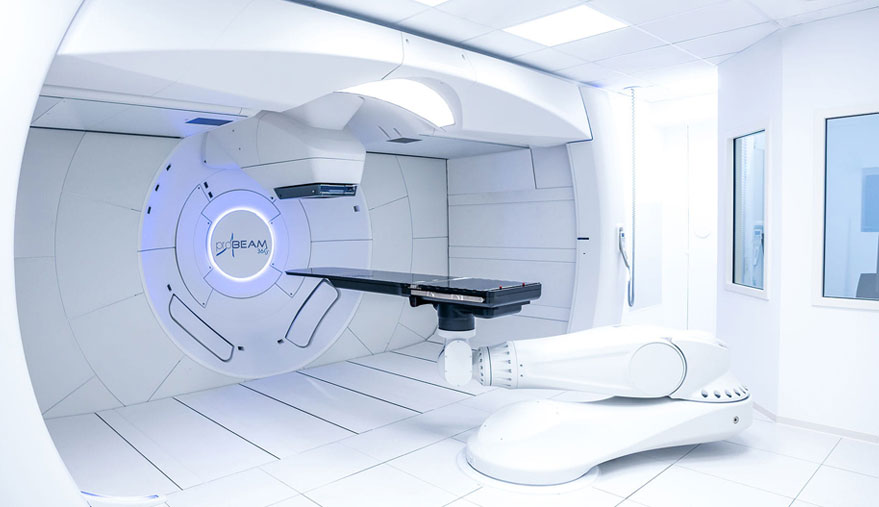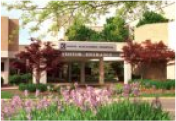Home » Cancer Types » Breast Cancer
Breast Cancer
- Overview
- Treatment Options
- What to Expect
If you have just been diagnosed with breast cancer, understanding the disease and the treatment options can be very confusing and overwhelming. After your diagnosis, you and your treatment team–which usually consists of your surgeon, medical oncologist, radiation oncologist and possibly a plastic surgeon–will put together a treatment plan specific to your situation. Your treatment plan will be made up of one or more types of treatments that are intended to eradicate the local disease in the breast, and reduce the risk of the disease spreading elsewhere in your body. What type of treatment is recommended for you depends on several factors, including the stage of your disease.
ROA physicians offer the most experience, the broadest array of options, and the most individualized approach to breast cancer treatment in Northern Virginia. Our radiation oncologists have treated thousands of women with breast cancer, and we emphasize the “team” approach to care, working closely with breast surgeons, medical oncologists, and other providers to optimize care.
We attend weekly breast cancer conferences with these colleagues to provide the most comprehensive and high quality care possible.
Radiation therapy, along with surgery, is used to treat the local or regional disease, typically within the breast and/or nearby lymph nodes. Options to treat the whole body or prevent spread are called “systemic”, and may include hormonal therapy or chemotherapy. Systemic therapies are generally given under the guidance of a Medical Oncologist.
Radiation therapy can be given after breast-preserving surgery to maximize the chance of cure, and is sometimes used after mastectomy for more advanced or high-risk disease. Treatments can range from 1 week to 7 weeks in duration, and can treat a portion of the breast or the entire breast and lymph nodes, depending on each patient’s unique situation.
WHOLE BREAST IRRADIATION (WBI)
For many women who need radiation therapy after breast-conserving surgery, whole breast irradiation (WBI) remains the gold standard of care. This treatment, when added to breast-conserving surgery (also known as lumpectomy) for early stage breast cancer, provides the same long-term disease control and survival as mastectomy. Backed by decades of experience for thousands of women, whole breast irradiation is proven to significantly enhance local control of breast cancer, with long-term evidence of excellent local control and minimal long-term toxicity. ROA physicians use the latest advancements in technology, including 3D-conformal, IMRT, proton therapy (hyperlink to proton therapy section), and IGRT to treat the breast while sparing surrounding healthy tissues. These technologies allow us to carefully avoid or minimize exposure to normal tissues, including the heart and lungs.
Although historically most patients required 6 to 7 weeks of treatment for whole breast irradiation, recent evidence has demonstrated that for selected patients, shorter schedules of treatment (3 to 4 weeks) can be equally safe and effective. ROA physicians are experienced and knowledgeable about these options, and will discuss with you which treatment is best for your situation.
ACCELERATED PARTIAL BREAST IRRADIATION (PBI)
For patients who undergo lumpectomy, APBI, or accelerated partial breast irradiation, is the option of treating only a portion of the breast after lumpectomy with radiation therapy. Because the volume of treatment is much smaller, treatments can typically be delivered more quickly, in as little as 5 days (known as acceleration).
There are two different approaches to APBI:
is delivered in a similar way to standard whole breast radiation. In this scenario, radiation is delivered through an external source using a linear accelerator. However, it is more focused on the area around the surgery. Treatment is given every other day over a 5 day period. Using an IMRT (hyperlink to IMRT section) technique, radiation is directed only to area around the lumpectomy cavity.
(internal radiation) involves a balloon-like device (BLD), directly into the cavity where the cancer was taken out. ROA offers PBI with 2 brachytherapy devices–Mammosite and Contura.Your ROA physician will then prescribe the appropriate radiation dose to the tumor bed region via internal radiation that is delivered into the balloon device under computer guidance. The exact dose and targeting is determined by your radiation oncologist based on your individual situation.

APBI is an exciting option, but is not an appropriate treatment for every patient, and ROA physicians review the details of each patient’s situation to determine if this option should be considered. Because we have such a wide variety of treatment options and technologies, decisions are made on an individualized basis after thorough discussion and evaluation of risks and benefits. We do not believe in a “one size fits all” approach.
POST-MASTECTOMY RADIATION
For many women who undergo mastectomy (removal of the entire breast) for cancer treatment, radiation treatment is not needed. However, for patients whose lymph nodes are involved with cancer, who have large tumors, or whose tumor is close to the “margin” (the edge of what a surgeon can remove), radiation treatment can play a very important role in improving cancer control.
Technologies including 3D-conformal, IMRT, proton therapy (hyperlink to proton therapy), and IGRT are used for post-mastectomy radiation therapy, similar to whole breast treatment. Treatments are typically given over 6 to 7 weeks in order to safely treat the appropriate areas at risk with minimal long-term side effects.
Treatments given after mastectomy will typically target the chest wall and may also target the lymph nodes of the axilla (armpit) through the supraclavicular area (above the collarbone). For patients whose cancer has traveled to these lymph nodes, adding radiation therapy after mastectomy significantly enhances tumor control and reduces the risk of cancer spread (metastasis) in the future. Radiation therapy improves the cure rate and survival for many patients with significant node-positive disease.
RECONSTRUCTION AND RADIATION THERAPY
Patients who opt for reconstruction after mastectomy can still safely receive radiation therapy, but this requires coordination and communication amongst the physicians involved. Radiation treatment can be delivered to the reconstructed breast, but sometimes reconstruction is delayed until after radiation treatment has been completed and appropriate healing has taken place. ROA phyisicans have extensive experience in this situation and will discuss all options and techniques with your plastic surgeon to create a comprehensive and effective treatment plan.”
Effective, safe and compassionate patient care is our top priority
Breast and chest wall irradiation is usually well tolerated, and the side effects during treatment are relatively mild. You will typically develop a skin reaction during treatment that usually looks like a mild to moderate “sun-burn” of the skin of your breast or chest wall. You will be instructed in the appropriate skin care. You may also experience some fatigue towards the end of treatment, but this usually is not overwhelming. Most of our patients can go about their normal daily activities, or work full time throughout their treatment course. We encourage exercise as patients who do so regularly experience less fatigue. You are not radioactive, and can interact freely with friends and family, and even with children, and pregnant women.
We are very concerned about the potential for long term damage to underlying organs such as the heart and lung whenever we use radiation therapy in the chest area. With our sophisticated 3-dimensional treatment planning we can minimize the amount of radiation that any of these organs receives. Therefore, your risk of long term lung or (if the left breast is treated) heart injury from the radiation treatment is very small. During the course of treatment, images or x-rays of the treatment area are taken weekly to assure that you are setting up perfectly. These are checked by your physician.
Your personal care team consists of your physician, oncology nurse, radiation therapists, nutritionist and social worker. During your treatment, you will meet with your physician (or, in his or her absence, one of our other physicians) weekly to address any questions you might have, and for the physician to evaluate how you are tolerating treatment. We are here to provide support, address your questions and concerns, and help you move forward through your treatment into recovery.
Effective, safe and compassionate patient care is our top priority
Latest News
Dr. Lonika Majithia publishes on The Clinical Utility of DCISionRT on Radiation Therapy Decision Making in Patients with Ductal Carcinoma In Situ Following Breast-Conserving Surgery in Annals of Surgical Oncology
Abstract Background The role of radiation therapy (RT) following breast-conserving surgery (BCS) in ductal carcinoma in situ (DCIS) remains controversial. Trials have not identified a low-risk cohort, based on clinicopathologic features, who do not benefit from RT. A biosignature (DCISionRT®) that evaluates recurrence risk has been developed and validated. We evaluated the impact of DCISionRT […]
Dr. Avani Rao publishes on plan quality effects of proton therapy for central nervous system and skull base tumors in Radiotherapy and Oncology
Abstract Purpose With reports of CNS toxicity in patients treated with proton therapy at doses lower than would be expected based on photon data, it has been proposed that heavy monitor unit (MU) weighting of pencil beam scanning (PBS) proton therapy spots may potentially increase the risk of toxicity. We evaluated the impact of maximum […]
Dr. Daniel Kim publishes on the implications of practice consolidation among radiation oncologists
Abstract Purpose Health care practices across the United States have been consolidating in response to various market forces. The degree of practice consolidation varies widely across specialties but has not been well studied within radiation oncology. This study used Medicare data to characterize the extent of practice consolidation among radiation oncologists and to investigate associated […]
Cancer Types
Radiation Oncology Associates is the leader in comprehensive and cutting-edge radiation oncology therapy services in convenient and accessible locations across Northern Virginia.









